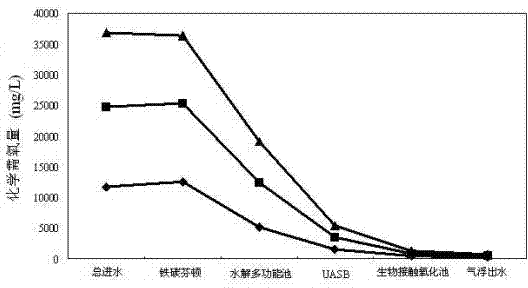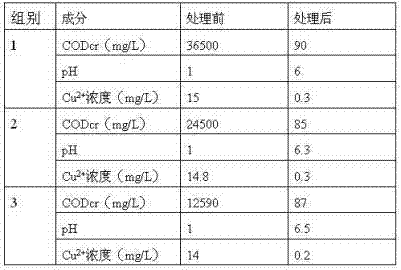Method for treating saccharin wastewater
A treatment method and wastewater technology, which can be used in water/sewage treatment, natural water treatment, flotation water/sewage treatment, etc., and can solve problems such as failure to meet secondary discharge standards and poor effect.
- Summary
- Abstract
- Description
- Claims
- Application Information
AI Technical Summary
Problems solved by technology
Method used
Image
Examples
specific Embodiment approach 1
[0007] Embodiment 1: The treatment method of saccharin wastewater according to the present embodiment is carried out according to the following steps: 1. Add saccharin wastewater to a reactor equipped with a mixture of iron filings and activated carbon, and then press wastewater: hydrogen peroxide = 1: 0.1~ Add hydrogen peroxide at a volume ratio of 0.5, and adjust Fe 2+ The concentration is 50mg / L~200mg / L, the pH value is 4~5, and the hydraulic retention time is 2.0h~3.5h; 2. The effluent treated in step 1 flows into the first sedimentation tank for sedimentation treatment; The supernatant obtained after the treatment in step 2 flows into the hydrolysis multifunctional pool, and the concentration of anaerobic activated sludge in the hydrolysis multifunctional pool is 10kg / m 3 ~20kg / m 3 , the dissolved oxygen content is 0.1mg / L~0.3mg / L, the pH value is 4~5, and the hydraulic retention time is 10h~14h; 4. The supernatant obtained after the treatment in step 3 flows into the up...
specific Embodiment approach 2
[0009] Specific embodiment 2: The difference between this embodiment and specific embodiment 1 is that in step 1, hydrogen peroxide is added according to the volume ratio of waste water: hydrogen peroxide = 1:0.2~0.4, and the Fe 2+ The concentration is 60mg / L~180mg / L, the pH value is 4.2~4.8, and the hydraulic retention time is 2.2h~3.3h. Others are the same as in the first embodiment.
specific Embodiment approach 3
[0010] Specific embodiment three: the difference between this embodiment and specific embodiment one or two is: in step one, add hydrogen peroxide according to the volume ratio of waste water: hydrogen peroxide = 1:0.3, and adjust Fe 2+ The concentration is 100mg / L, the pH value is 4.5, and the hydraulic retention time is 2.8h. Others are the same as in the first or second embodiment.
PUM
| Property | Measurement | Unit |
|---|---|---|
| clearance rate | aaaaa | aaaaa |
Abstract
Description
Claims
Application Information
 Login to View More
Login to View More - R&D
- Intellectual Property
- Life Sciences
- Materials
- Tech Scout
- Unparalleled Data Quality
- Higher Quality Content
- 60% Fewer Hallucinations
Browse by: Latest US Patents, China's latest patents, Technical Efficacy Thesaurus, Application Domain, Technology Topic, Popular Technical Reports.
© 2025 PatSnap. All rights reserved.Legal|Privacy policy|Modern Slavery Act Transparency Statement|Sitemap|About US| Contact US: help@patsnap.com


